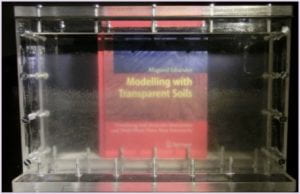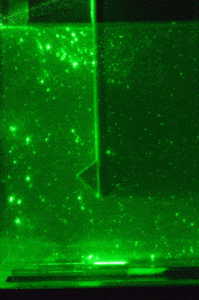 |
Reference viewed behind a 5 cm thick model made of transparent soil.
Natural soils are opaque to visible light, so the only way to visualize internal deformations and flow paths within them is through expensive apparatuses such as X-rays, computerized tomography (CT), or magnetic resonance imaging (MRI) cameras. Although this equipment exists, it remains very expensive and difficult to use, particularly in educational settings. Transparent soils have been developed as a means of overcoming these difficulties.
The fundamental premise of this work is that transparent synthetic materials with geotechnical properties similar to those of natural soils can be used to study 3D deformation and flow problems in natural soils. Transparent soils are two-phase media made by refractive index (RI) matching of solids representing the soil skeleton and the saturating fluids.

Professor Iskander and his students at NYU have been leading the development of transparent soils and their use for physical modeling of geotechnical phenomena. Other research groups, around the world, have focused on the application of transparent soils to study a variety of geotechnical phenomena. This wiki is primarily based on research conducted at NYU, but it also points to contributions by research teams elsewhere.
Primary References
- Iskander, M., R. Bathurst, and M. Omidvar (2015). Past, present, and future of transparent soils. Geotechnical Testing Journal., Vol. 38, No. 4, pp. 511-536, doi: 10.1520/GTJ20140267, ASTM [link]
- Iskander, M., R. Bathurst, (2015). Special issue of the Geotechnical Testing Journal on Physical Modeling with Transparent soils Vol. 38, No. 5, ASTM
- Iskander , M. (2010). Modeling with transparent soils, visualizing soil structure interaction and multi phase flow, non intrusively. ISBN: 978-3642025006, Springer, 331 p. [link]
